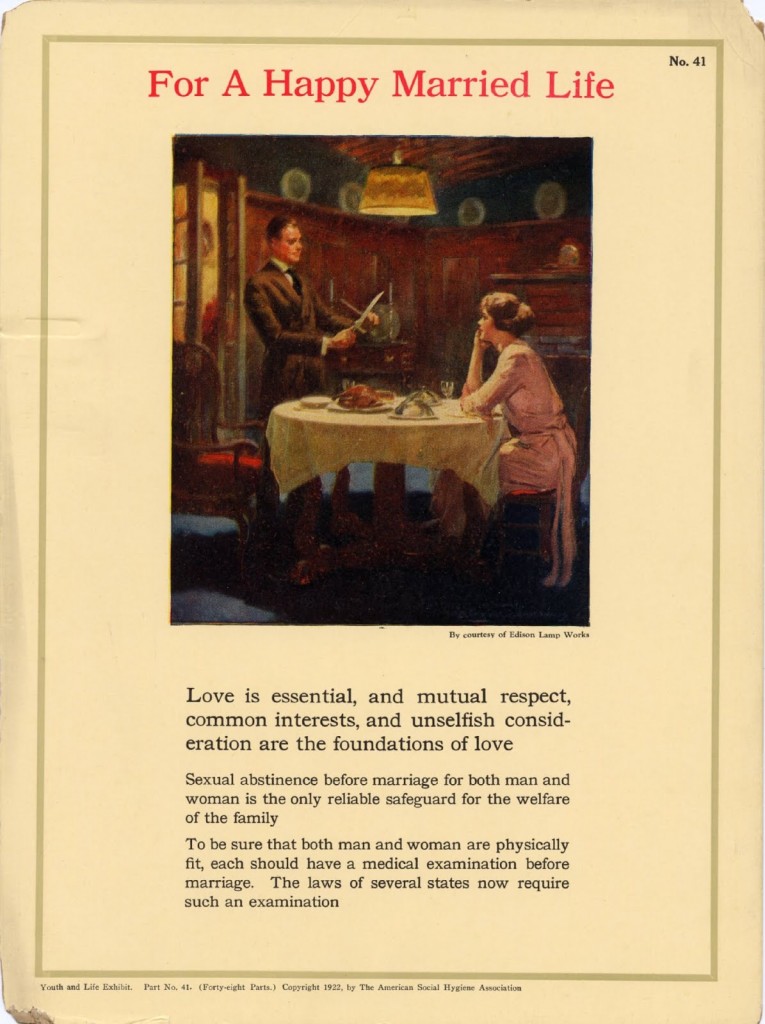In the nativist 1920s, in the wake of successive waves of mass immigration from Southern and Eastern Europe, progressives in the United States engaged in tremendous efforts to assimilate immigrants into their vision of American culture. For these white, middle-class, and Protestant reformers, channeling sexuality into marriage was key to this enterprise. In this moment, after WWI, many Americans embraced anti-radical and anti-immigration positions. These sentiments coincided with sexual modernism—a refashioning of gender roles and the separation of sexual activity from marriage and reproduction—and together the two streams informed progressives’ response to immigrants. An “American Style” marriage, reformers believed, was one solution to the problem of unassimilated immigrants failing to adjust to modern life in the United States.

Factory work, dancehalls, dark movie theaters, and amusement parks pulled immigrant daughters out of their homes, away from family chores and Old World influences. Urban leisure activities excited young men and women with the possibility of mixed-sex fun. In response to these changing gender and sexual mores, progressive Americanizers promoted marriage as the only available outlet for sexual behavior. Marriage, in their view, functioned as a vital social institution, one that would contain the disruptive potential of changing sex and gender norms. And so, as immigrant sons and daughters grappled with new forms of leisure, freedoms for women, and a range of sexual possibilities, reformers made allowances for pre-marital sexual experimentation even as they promoted marriage as the only appropriate site for sex. For reformers, marriage and families facilitated the maintenance of a vulnerable moral order, the smooth assimilation of working people in a period marked by fear of radical unrest, and the financial solvency of immigrant households.
The incorporation of sexual modernism into anti-radical and anti-immigrant politics could be seen in the efforts of moral crusaders such as John Sumner, Secretary of the New York Society for the Suppression of Vice (SSV). In 1921, Sumner identified unassimilated immigrants as partly to blame for the disintegration of “American morals,” and he hoped that Americanization programs might better introduce the “foreign element” to “American ideals.” Settlement house workers likewise recognized that with the tumult of adolescence in America and the confusing clash of traditions, immigrant youth faced complicated sexual arrangements with little guidance from parents or from their national communities. The United Neighborhood Houses of New York (UNH), a collective of some forty settlement houses in the region, stepped into the fray by identifying the young immigrant’s budding sexuality as a potential site of assimilation. UNH leaders developed a “social education” program to address the social and political forces structuring these young people’s lives, and in 1927 the first course ran, serving a diverse range of immigrants and immigrants’ children, ages eighteen to twenty-two, from houses all over the New York City area.
These social education courses created a space for immigrant youth to discuss alternatives to marital heterosexuality, but ultimately served to reinforce marriage. Topics covered reflected the young audience’s interests, and typically, sexuality dominated their discussions. The suggested reading list in 1928 included the works of a number of well-known sex radicals, so course leaders did not necessarily make “safe” choices. Settlement workers understood the array of sexual options amenable to their young audience, and valued their openness. Indeed, participants, voicing the concerns of a distinctly modern youth, used this space at times to challenge heterosexual norms by frankly questioning whether and how they should resist sex outside of marriage. They wondered outright how to best direct their sexual and emotional energies. Pushed to offer “substitutes for marriage during the years from adolescence to the time when we can marry,” participants presented a breathtaking range of possibilities they felt were available to them. Ideas winning more than ten votes from the group as worthy of discussion included platonic friendship, companionate marriage, free love, petting, homosexual crushes, and prostitution. Other, less popular options included masturbation, self-restraint, and promiscuous sexual relations. Settlement youths had their fair share of sexual knowledge, and their sense of the possible far exceeded that of official discourse.

Settlement workers encouraged young men and women to engage in open and probing discussions in these forums, and often they looked surprisingly soberly at the institution of marriage. Some participants privileged romance and emotional attachments, criticizing companionate marriage for taking “the beauty out of such a relationship.” A very popular but controversial topic at the time, the notion of companionate marriage assumed childlessness at first (through a reliance on birth control) and thus made divorce easier if the relationship soured. Some revealed a fundamental awareness of the power of economic motivations in marriage. And while many agreed that the era of women’s rights had arrived, they pondered the potential impact of this development on real marriages.
But despite all of this, course leaders moved to mediate any tendency toward genuinely radical inclinations. Tempering the rising acceptance of sex for its own sake, these settlement workers offered up a model of heterosexuality that encompassed some changes and cut off others. For instance, in a discussion of the “right and wrong” of petting, a course leader warned that “promiscuous petting” could result in “an unhappy marriage.” A participant interrupted, arguing that such a claim “implies that marriage as we have it now, is a good institution.” On this, group members disagreed. In another discussion, this one on the timely topic of “monogamy versus free love,” a course leader posed his belief that, “If a man really loves a woman, his only desire is toward a monogamous existence.” Here, reformers advocating enlightened sexual thought still blunted the impact of sex modernism, packaging sexuality as exclusively heterosexual, marital, and monogamous by the late 1920s.
For these reformers, in an anti-immigrant, anti-radical, sexually modernizing era, the sexual adjustment of immigrant youth mattered profoundly. Unassimilated immigrants were viewed as disruptive and unfit for citizenship. Heterosexual marriage, however, became a path to adjustment, for within its confines American values could be instilled and reproduced. The immigrant family, in other words, became a site of social reproduction, a space that could produce ‘American’ values and identities just as it reproduced immigrants’ labor power daily and generationally. Reinforcing that family allowed reformers to ameliorate the social and political costs of strained family relationships and disorderly youth. In the interests of Americanization, erotic and gender behavior needed direction. Reformers hoped these efforts might thwart non-marital sex, or, worse yet in their view, “the propensity for those of the same sex.” Ultimately, their deployment of marital heterosexuality in the service of national stability served to further solidify heterosexual norms in the 1920s.
 Erica Ryan is an Assistant Professor in the History Department at Rider University in New Jersey. She is the author of Red War on the Family: Sex, Gender, and Americanism in the First Red Scare (Temple, 2014). She is in the beginning stages of two new projects: one examines fatherhood in 1990s American political culture, and the other links contemporary American “culture wars” to the political, social, and cultural divides of the 1920s.
Erica Ryan is an Assistant Professor in the History Department at Rider University in New Jersey. She is the author of Red War on the Family: Sex, Gender, and Americanism in the First Red Scare (Temple, 2014). She is in the beginning stages of two new projects: one examines fatherhood in 1990s American political culture, and the other links contemporary American “culture wars” to the political, social, and cultural divides of the 1920s.

NOTCHES: (re)marks on the history of sexuality is licensed under a Creative Commons Attribution-NonCommercial-NoDerivatives 4.0 International License.
Based on a work at www.notchesblog.com.
For permission to publish any NOTCHES post in whole or in part please contact the editors at NotchesBlog@gmail.com




